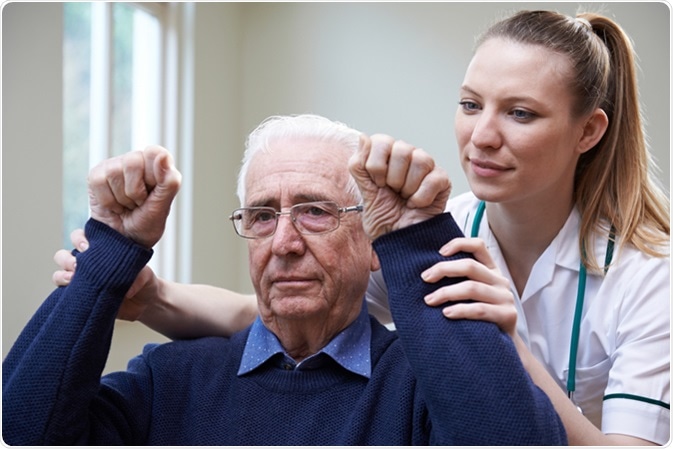Stroke is a serious medical condition where the blood supply to the brain is disrupted, either through a blockage (ischaemic stroke) or a rupture (haemorrhagic stroke). Stroke is a medical emergency and requires urgent medical attention in order to prevent serious, long lasting and life threatening damage.

Nurse Assessing Stroke Victim By Raising Arms. Image Credit: SpeedKingz / Shutterstock
Symptoms of Stroke
The symptoms of stroke are variable, depending on what part of the brain is affected. However, some general symptoms to look for can be summarised by FAST:
- F - Face - Stroke can cause paralysis of the facial muscles that may present as drooping of the face on one side and an inability to smile.
- A - Arms - Weakness, heaviness and numbness in the upper body limbs may affect the ability to lift one or both arms.
- S - Speech - Speech may be slurred, garbled or completely absent.
- T - Time - Time is a vital parameter in stroke patients. The earlier a patient receives medical attention, the less risk there is of potentially devastating consequences.
As a result of severe stroke, patients may display cognitive decline, which may progress onto dementia (usually vascular dementia). Other symptoms may include complete paralysis of one side of the body, confusion, language comprehension difficulties, loss of vision, motor coordination and balance irregularities, dysphagia and sometimes an extremely sudden onset severe headache.
Causes of Stroke
The brain is a highly vascularized organ and has a rich supply of blood vessels. This network of blood vessels allows for an adequate blood supply to all parts of the brain. If the blood supply to any brain region is disrupted, neurons and other cells in that particular region begin to die, with symptoms correlating to what part of the brain is affected. For example, if the blood supply to the motor cortex is disrupted through a blockage of the middle cerebral artery, control of the voluntary movement of the body is affected, leading to paralysis.
There are two main types of stroke. Ischaemic stroke is one of the most common forms of stroke, and arises when there is a blood clot (thrombus) or the presence of fatty deposits (atheromatous plaques) within the lumen of brain vessels. These clots/plaques arise due to the process of atherosclerosis or cardiovascular disease. Risk factors for developing atherosclerosis include high blood pressure (hypertension), high blood cholesterol (hypercholesterolaemia), obesity, type-2 diabetes mellitus as well as excessive alcohol consumption.
There may also be smaller strokes known as transient ischaemic attacks (TIAs) in which there is a temporary occlusion of a blood vessel depriving a region of the brain with oxygen. Unlike strokes, these usually resolve within a day, and the symptoms may only last a few minutes. These can be frequent and often go unnoticed. However, over time they may cause a progressive decline in brain function and physiological performance. For example, multi infarcts can directly cause the onset of vascular dementia, whose symptoms would worsen with each TIA.
The second type of stroke is a haemorrhagic stroke, which occurs when there is a rupture of a weakened blood vessel (usually caused by an aneurysm, predominantly in the subarachnoid layer of the meninges). The leaking blood accumulates and causes compression of the surrounding brain tissue, as well as depriving that area of the brain with oxygen. As with ischaemic strokes, risk factors are usually overlapping, although hypertension is the key factor for haemorrhagic strokes. Stress may exacerbate hypertension, and may be a causative factor in haemorrhagic strokes.
Treatment of Stroke
In order to prevent stroke, or future strokes, thrombolytic drugs such as alteplase may be used to dissolve blood clots and restore blood flow. Antiplatelets such as aspirin may also be prescribed reduce the chance of clot formation in the future. Other blood-clotting preventing medications such as warfarin and heparins can also be administered long-term, especially if you have a history of clotting or deep vein thrombosis.
Other medications can also be used to reduce the risk of developing stroke such as those that reduce blood cholesterol levels (statins). These may reduce the risk of atheromatous plaques forming within the blood vessels of the brain.
In some cases, surgery may also be performed to clear an obstruction or to repair a ruptured vessel. In order to perform such surgeries, a piece of the skull is removed (craniotomy) and often replaced with a metal plate. Occasionally, as a result of haemorrhagic stroke, cerebrospinal fluid (CSF) can build up within the ventricles causing hydrocephalus. In such cases, a shunt in inserted into the brain to drain the fluid and reduce intracranial pressure.
Major strokes that are not fatal, often leave the patients with short or long-term physiological consequences. For example, if leg paralysis occurs, there is an increased risk of developing deep vein thrombosis (DVT). Tight compression socks or stockings may be offered to prevent clotting in the leg. Some patients may have problems with swallowing (dysphagia) and may need a feeding tube inserted directly into the stomach via the nose. Patients may even have to undergo occupational therapy if movement and fine motor control is affected.
All of the above treatments can be used after (as a treatment) or before a stroke (as prevention). However, ensuring you have a good health and a reduced risk of cardiovascular disease may prevent strokes altogether, by tackling obesity, hypertension and high cholesterol levels. Therefore, adopting an active lifestyle may reduce the overall risk of stroke and dementia.
Sources
- Donnan et al, 2008. Lancet. 371(9624):1612-23 https://www.ncbi.nlm.nih.gov/pubmed/18468545
- https://www.nhs.uk/conditions/stroke/
- Iadecola C (2013) The pathobiology of vascular dementia. Neuron 20;80(4):844-66 https://www.ncbi.nlm.nih.gov/pubmed/24267647
Further Reading
Last Updated: Nov 12, 2018